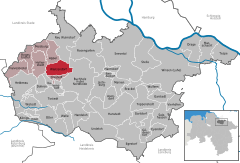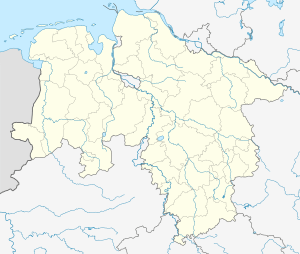Wenzendorf
Wenzendorf is a municipality in Lower Saxony, Germany. It is also the name of the chief village of the municipality.
Wenzendorf | |
|---|---|
 Coat of arms | |
Location of Wenzendorf within Harburg district   | |
 Wenzendorf  Wenzendorf | |
| Coordinates: 53°21′N 09°46′E | |
| Country | Germany |
| State | Lower Saxony |
| District | Harburg |
| Municipal assoc. | Hollenstedt |
| Subdivisions | 5 |
| Government | |
| • Mayor | Manfred Cohrs |
| Area | |
| • Total | 21.47 km2 (8.29 sq mi) |
| Elevation | 64 m (210 ft) |
| Population (2018-12-31)[1] | |
| • Total | 1,440 |
| • Density | 67/km2 (170/sq mi) |
| Time zone | CET/CEST (UTC+1/+2) |
| Postal codes | 21279 |
| Dialling codes | 04165 |
| Vehicle registration | WL |
| Website | |
The area is known mainly for the airfield near the village, where the Hamburger Flugzeugbau, the aircraft manufacturing arm of Blohm & Voss, built a factory during the Nazi era.
Municipality
Wenzendorf is a municipality in the Lower Saxony district of Harburg, Germany. Its five main villages are Wenzendorf, Wennerstorf, Klauenburg, Dierstorf and Dierstorf-Heide.
Wenzendorf is the largest Christmas tree growing area in northern Germany.[2]
Wenzendorf village
The village of Wenzendorf lies approximately 25 km southwest of Hamburg. It has a population of a little over 1,000.
Airfield
Wenzendorf airfield lies about 2 km to the southeast of the main village.
Aircraft factory
In 1934, Hamburger Flugzeugbau began construction of its first dedicated aircraft factory at Wenzendorf and laid out a large aerodrome for test flying. The factory began operation in 1935, license-building the Dornier Do 23, the first of which flew in December 1935.[3]
Not long afterwards the company adopted its parent company's name of Blohm and Voss, by which it is chiefly remembered.
A great many aircraft were assembled at Wenzendorf throughout the war period, mostly under sub-contract to other manufacturers. They included:
- Dornier Do 23
- Dornier Do 17
- Junkers W 34
- Junkers Ju 86
- Junkers Ju 88
- Blohm & Voss BV 141 prototypes and pre-production batches
- Blohm & Voss BV 155 prototypes
- Blohm & Voss BV 40 prototypes
- Messerschmitt Bf 109
- Messerschmitt Bf 110
- Messerschmitt Me 210
- Messerschmitt Me 262
On 6 October 1944 the plant was severely damaged in a bombing raid by the US Air Force, and three months later was almost completely destroyed in a second attack.[4][5]
Modern use
Today, the airfield is much reduced in size. It has a single grass runway of 750m length and is home to the Airbus HFB gliding club.
Some of the old factory buildings have been converted to a retirement home.[6]
References
- Landesamt für Statistik Niedersachsen, LSN-Online Regionaldatenbank, Tabelle 12411: Fortschreibung des Bevölkerungsstandes, Stand 31. Dezember 2018.
- Die Zeit: Der Baumbauer 19. Dezember 2007
- Hermann Pohlmann; Chronik Eines Flugzeugwerkes 1932-1945, Motorbuch, 2nd Impression, 1982. (In German).
- RonaldV; "Wenzendorf", Abandoned, Forgotten & Little-Known airfields in Europe. (Retrieved 25 June 2017)
- Flugzeugwerk und Flugplatz Wenzendorf (in German). (Retrieved 25 June 2017)
- Eighth Air Force Historical Society